Royal Norwegian Navy
| Royal Norwegian Navy Sjøforsvaret | |
|---|---|
|
Coat of arms | |
| Country |
|
| Allegiance | Kingdom of Norway |
| Branch | Navy |
| Size | 3,900 personnel (as of 2013; Does not include Naval Home Guard)[1] |
| Part of | Military of Norway |
| Engagements |
Swedish War of Liberation (1510–23) Count's Feud (1534–36) Nordic Seven Years' War (1563–70) Kalmar War (1611–13) Torstenson War (1643–45) Second Nordic War (1657–60) Scanian War (1675–79) Great Nordic War (1700 & 1709–20) Battle of Copenhagen (1801) Battle of Copenhagen (1807) Gunboat War (1807–14) First Schleswig War (1848–51) World War II (1940–45) Cold War (1945–90) War on terror (2001– ) |
| Commanders | |
| Commander in Chief | King Harald V |
| Inspector General of the Navy | Rear Admiral Lars Saunes[2] |
| Notable commanders |
Peter Tordenskjold Cort Adeler Niels Juel Lauritz Galtung Kristoffer Throndsen Henrik Bjelke |
| Insignia | |
| Pennant and Naval Jack |
 |
| Naval Ensign |
 |
| |
| Components |
|---|
| Navy (Coast Guard) Air Force Home Guard Cyber Defence Force |
| Ranks |
| Norwegian military ranks |
| Bugle calls |
| Bugle calls of the Norwegian Army |
| Armed Forces equipment |
| Army equipment Norwegian naval ships Norwegian military aircraft |
The Royal Norwegian Navy (Norwegian: Sjøforsvaret, "the naval defence (forces)") is the branch of the Norwegian Armed Forces responsible for naval operations of the state of Norway. As of 2008, the RNoN consists of approximately 3,700 personnel (9,450 in mobilized state, 32,000 when fully mobilized) and 70 vessels, including 5 heavy frigates, 6 submarines, 14 patrol boats, 4 minesweepers, 4 minehunters, 1 mine detection vessel, 4 support vessels and 2 training vessels. The navy also includes the Coast Guard.
The Royal Norwegian Navy has a history dating back to 955. From 1509 to 1814, it formed part of the navy of Denmark-Norway, also referred to as the "Common Fleet". Since 1814, the Royal Norwegian Navy has again existed as a separate navy.
In Norwegian, Royal Norwegian Navy vessels have since 1946 been given the ship prefix "KNM", short for Kongelig Norske Marine (Royal Norwegian Navy). In English, they are given the prefix "HNoMS", short for "His/Her Norwegian Majesty's Ship". Coast Guard vessels are given the prefix "KV" for KystVakt (Coast Guard) in Norwegian and "NoCGV" for Norwegian Coast Guard Vessel in English.
History
The history of Norwegian state-operated naval forces is long, and goes back to the leidang which was first established by King Håkon the Good at the Gulating in 955, although variants of the Leidang had at that time already existed for hundreds of years.
During most of the union between Norway and Denmark the two countries had a common fleet. This fleet was established by King Hans in 1509. A large proportion of the crew and officers were Norwegian. In 1709 there were about 15,000 personnel enrolled in the common fleet; of these 10,000 were Norwegian. When Tordenskjold carried out his famous raid at Dynekil in 1716 more than 80 percent of the sailors and 90 percent of the soldiers in his force were Norwegian. Because of this the Royal Norwegian Navy shares its history from 1509 to 1814 with the Royal Danish Navy.
The modern, separate Royal Norwegian Navy was founded on April 12, 1814 by Prince Christian Fredrik. At the time of separation, the Royal Dano-Norwegian Navy was in a poor state and Norway was left with the lesser share. All officers of Danish birth were ordered to return to Denmark and the first commander of the Norwegian navy became Captain Thomas Fasting. It then consisted of 39 officers, seven brigs (one more under construction), one schooner-brig, eight gun schooners, 46 gun chalups and 51 gun barges.[3] April 1, 1815 the RNoN's leadership was reorganized into a navy ministry, and Fasting became the first navy minister.
Norway retained its independent armed forces, including the navy, during the union with Sweden. During most of the union the navy was subjected to low funding, even though there were ambitious plans to expand it. In the late 19th century, the fleet was increased to defend a possible independent Norway from her Swedish neighbours.
In 1900, just five years prior to the separation from Sweden, the navy, which was maintained for coastal defense, consisted of: two British-built coastal defence ships (HNoMS Harald Haarfagre and HNoMS Tordenskjold – each armored and displacing about 3,500 tons), four ironclad monitors, three unarmored gun vessels, twelve gunboats, sixteen small (sixty ton) gunboats, and a flotilla of twenty-seven torpedo boats.[4] These were operated by 116 active duty officers (with an additional sixty reserve) and 700 petty officers and seamen.[5]
Norway was neutral during World War I, but the armed forces were mobilised to protect Norway's neutrality. The neutrality was sorely tested – the nation's merchant fleet suffered heavy casualties to German U-Boats and commerce raiders.
World War II began for the Royal Norwegian Navy on April 8, 1940, when the German torpedo boat Albatross attacked the guard ship Pol III. In the opening hours of the Battle of Narvik, the old coastal defence ships ("panserskip") HNoMS Eidsvold and HNoMS Norge, both built before 1905 and hopelessly obsolete, attempted to put up a fight against the invading German warships; both were torpedoed and sunk. The German invasion fleet heading for Oslo was significantly delayed when Oscarsborg Fortress opened fire with two of its three old 28 cm guns, followed by the 15 cm guns on Kopås on the eastern side of the Drøbak strait. The artillery pieces inflicted heavy damage on the German heavy cruiser Blücher, which was subsequently sunk by torpedoes fired from Oscarsborg's land based torpedo battery. Blücher sank with over 1,000 casualties among its crew and the soldiers it carried. The German invasion fleet – believing Blücher had struck a mine – retreated south and called for air strikes on the fortress. This delay allowed King Haakon VII of Norway and the Royal family, as well as the government, to escape captivity.

On June 7 1940, thirteen vessels, five aircraft and 500 men from the Royal Norwegian Navy followed the King to the United Kingdom and continued the fight from bases there until the war ended. The number of men was steadily increased as Norwegians living abroad, civilian sailors and men escaping from Norway joined the RNoN. Funds from Nortraship were used to buy new ships, aircraft and equipment.
Ten ships and 1,000 men from the Royal Norwegian Navy participated in the Normandy Invasion in 1944.
During the war the navy operated 118 ships, at the end of the war it had 58 ships and 7,500 men in service. They lost 27 ships, 18 fishing boats (of the Shetland bus) and 933 men in World War II.[6]
The Royal Norwegian Navy had its own air force from 1912 to 1944.
The building of a new fleet in the 1960s was made possible with substantial economic support from the United States. During the cold war, the Royal Norwegian Navy was optimized for sea denial in coastal waters, in order to make an invasion from the sea as difficult and costly as possible. With that mission in mind, the RNoN consisted of a large number of small vessels and up to 15 small diesel-electric submarines. The Royal Norwegian Navy is now replacing those vessels with a smaller number of larger and more capable vessels.
The Royal Norwegian Navy Museum is dedicated to the preservation and promotion of Norway's naval history.
Ensign and Jack
-

Naval Ensign 1814–1815.
-
.svg.png)
Naval Ensign 1815–1844
(during Union with Sweden, also used by the Swedish Navy) -
.svg.png)
Naval Ensign 1844–1905
(during Union with Sweden) -

Naval Ensign since 1905
-
.svg.png)
Naval Jack 1844–1905
(during Union with Sweden, also used by the Swedish Navy) -

Naval Jack since 1905
Bases
Some of The Royal Norwegian Navy's bases are:
- Haakonsvern, Bergen (main base for the navy).
- Ramsund, between the towns of Harstad and Narvik (special operations/Marinejegerkommandoen)
- Trondenes fort, Harstad (Coastal Ranger Command)
- Sortland (Coast Guard Squadron North)
- Karljohansvern, Horten (training facility)
Organization
The Navy is organized into the Fleet, the Coast Guard, and the Naval Schools. The Fleet consists of:
- Fleet Chief Staff,
- Frigate Branch (Fregattvåpenet),
- Submarine Branch (Ubåtvåpenet),
- MTB Branch (MTB-våpenet),
- Mine Branch (Minevåpenet)
- Norwegian Special Warfare Group (Marinens jegervåpen)
- Logistics Branch (Logistikkvåpenet).
The Naval Schools are:
- Royal Norwegian Naval Basic Training Establishment, KNM Harald Haarfagre, Stavanger
- Royal Norwegian Navy Officer Candidate School, Horten and Bergen
- Royal Norwegian Naval Academy, Laksevåg, Bergen
- Royal Norwegian Naval Training Establishment, KNM Tordenskjold, Haakonsvern, Bergen
Two of the schools of the Navy retain ship prefixes, reminiscent of Royal Navy practises.[7]
Museum: Royal Norwegian Navy Museum, Horten
Fleet units and vessels (present)

Frigate Branch
NOTE: These ships are generally considered destroyers by their officers and other navies due to their size and role.[8]
- Fridtjof Nansen-class frigate. Five vessels commissioned.
- Fridtjof Nansen (F310) Launched June 3, 2004. Commissioned April 5, 2006.
- Roald Amundsen (F311) Launched May 25, 2005. Commissioned May 21, 2007.
- Otto Sverdrup (F312) Launched April 28, 2006. Commissioned April 30, 2008.
- Helge Ingstad (F313) Launched November 23, 2007. Commissioned September 29, 2009.
- Thor Heyerdahl (F314) Launched February 11, 2009. Commissioned January 18, 2011.
- Royal yacht:
Mine Branch
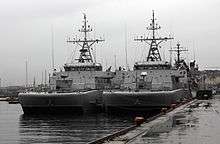
- 1st Mine Clearing Squadron
- Oksøy class mine hunter (1994)
- Oksøy M340
- Karmøy M341
- Måløy M342
- Hinnøy M343
- Oksøy class mine hunter (1994)

- Alta class mine sweeper (1996):[9]
- Alta M350
- Otra M351
- Rauma M352
- Orkla M353 (Ship sunk on 19 November 2002)
- Glomma M354
- Alta class mine sweeper (1996):[9]
- Naval EOD Commando

Submarine Branch
The submarine fleet consists of several Ula class submarines.
- 1st Submarine Squadron Ula class submarines:
MTB Branch
_(2_Nov_2001).jpg)
The Coastal Warfare fleet consists of Skjold class Corvettes.
- Missile Patrol Boat (Skjold class, all 6 commissioned:
- Skjold (P960) Launched September 22, 1998. Commissioned April 17, 1999
- Storm (P961) Launched November 1, 2006.
- Skudd (P962) Launched April 30, 2007.
- Steil (P963) Launched January 15, 2008.
- Glimt (P964)
- Gnist (P965)
Norwegian Navy Special Warfare Group
- Coastal Ranger Command
- Norwegian Naval EOD Commando
- Tactical Boat Squadron
- Combat Boat 90N (1996)[10]
- Trondenes
- Skrolsvik
- Kråkenes
- Stangnes
- Kjøkøy
- Mørvika
- Kopås
- Tangen
- Oddane
- Malmøya
- Hysnes
- Brettingen
- Løkhaug
- Søviknes
- Hellen
- Osternes
- Fjell
- Lerøy
- Torås
- Møvik
- Combat Boat 90N (1996)[10]
Marinejegerkommandoen (MJK) — Norwegian maritime special operations forces unit
Logistics Branch
- In the process of establishing a "logistics on keel" system, a 26,000 ton vessel has been ordered from Daewoo in South Korea, to replace two ships currently in service The new ship will be named HNoMS Maud [13] and will be the Royal Norwegian Navy's largest.[14] Construction of the ship will be completed in 2016.
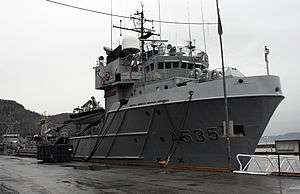
- Support vessel:
- Royal yacht:
- Minesweeper/minelayer:
- Safeguard ship for specialforces
2 Dockstavarvet AB type IC20M Iterceptor ( Two deliverd as of December 16th 2015. One option ) [15]
- August Nærø
- N/A

Coast Guard units and vessels

- Harstad
- Svalbard
- Andenes
- Nordkapp
- Senja
- Heimdal
- Farm
- Barentshav
- Sortland
- Bergen
- Ålesund
- Nornen
- Njord
- Tor
Navy vessels (future)
The Norwegian Navy is undergoing a major modernization project to reinforce its position as a modern and competent fleet. Some of these projects are the construction of five new Fridtjof Nansen class Aegis frigates, six new Skjold class patrol boats and numerous upgradings of existing models and vessels. All the Fridtjof Nansen and Skjold-class vessels are now in service. The next major re-equipment project for the Navy is replacing the current submarine fleet. The project is currently in the definition phase with options scheduled to be presented to the Government by the end of 2016.
DSME received an order for a combat support ship from the Norwegian Defense Logistics Organization. The value of this contract is approximately 230 million USD. The warship is scheduled to be delivered to the Norwegian Navy in September 2016.[16]
Insignia
| NATO Code | OF-10 | OF-9 | OF-8 | OF-7 | OF-6 | OF-5 | OF-4 | OF-3 | OF-2 | OF-1 | OF(D) | Student Officer | |
|---|---|---|---|---|---|---|---|---|---|---|---|---|---|
| (Edit) |
no equivalent |  |
 |
 |
 |
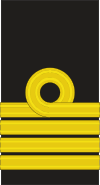 |
 |
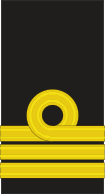 |
 |
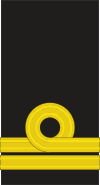 |
 |
no equivalent | no equivalent |
| Admiral | Viseadmiral | Kontreadmiral | Flaggkommandør | Kommandør | Kommandørkaptein | Orlogskaptein | Kapteinløytnant | Løytnant | Fenrik | ||||
| NATO Code | OR-9 | OR-8 | OR-7 | OR-6 | OR-5 | OR-4 | OR-3 | OR-2 | OR-1 | |||||||||||||||||||
|---|---|---|---|---|---|---|---|---|---|---|---|---|---|---|---|---|---|---|---|---|---|---|---|---|---|---|---|---|
(Edit) |
 |
 |
 |
 |
 |
 |
 |
 |
 |
 | ||||||||||||||||||
| Flaggmester | Orlogsmester | Flotiljemester | Skvadronmester | Kvartermester | Konstabel 1. klasse | Konstabel | Visekonstabel 1. klasse | Visekonstabel | Menig | |||||||||||||||||||
See also
References
Footnotes
- ↑ The Military Balance 2013 (2013 ed.). International Institute for Security Studies. 14 May 2013. pp. 160–162. ISBN 978-1857436808.
- ↑ "The Navy – Mil.no". Retrieved 14 December 2014.
- ↑ "Den norske Marine i 1814.". Retrieved 14 December 2014.
- ↑ Keltie, J.S., ed. The Stateman's Year Book: Statistical and Historical Annual of the States of the World for the Year 1900. New York: MacMillan, 1900. p 1066. (Retrieved via Google Books 3/5/11.)
- ↑ Keltie 1900, p. 1067.
- ↑ Berg, Ole F. (1997). I skjærgården og på havet – Marinens krig 8. april 1940 – 8. mai 1945 (in Norwegian). Oslo: Marinens krigsveteranforening. p. 154. ISBN 82-993545-2-8.
- ↑ Fact sheet from Department of Defense
- ↑ http://aviationweek.com/awin-only/us-studies-norwegians-manning-mindset
- ↑ "Kongsberg to Supply MINESNIPER Mk III Mine Disposal Weapon System to Royal Norwegian Navy". September 20, 2013.
- ↑ "The Royal Norwegian Navy is acquiring Navigation Equipment Package for Combat Boat 90". November 23, 2013.
- ↑ http://www.vg.no/forbruker/bil-baat-og-motor/baat/norske-kjoeremaskiner-vekker-oppsikt/a/23299605/
- ↑ http://www.batliv.com/wip4/detail.epl?id=414830
- ↑ Inngår kontrakt om nytt logistikkfartøy (Signs contract for new logistics vessel) Official page on www.regjeringen.no 2013 (Ministry of Defence (Norway) (Norwegian)
- ↑ "Norwegian Navy orders new logistics vessel". The Norway Post. NRK. 29 June 2013. Retrieved 12 October 2013.
- ↑ http://www.skipsrevyen.no/august-naero/
- ↑ NavyRecognition. "World Defence News: South Korea's DSME wins contract for design and build of a new logistics support vessel for Norway". Retrieved 14 December 2014.
External links
| Wikimedia Commons has media related to Royal Norwegian Navy. |
- Homepage of the Royal Norwegian Navy (Norwegian)
- English, Official site (English)
- Royal Norwegian Navy, Equipment Facts (English)
- Facts & Figures: The Royal Norwegian Navy (Norwegian Defence – Official Website) (English)
- Befalsbladet 1/2004 (Norwegian)
- Royal Norwegian Navy history page (Norwegian)
- Another Royal Norwegian Navy History page (Norwegian)
- Royal Norwegian Navy Museum web page (Norwegian)
- Royal Norwegian Navy Museum web page at mil.no (Norwegian)
- Fakta om Forsvaret 2006, issued January 2006 by the Ministry of Defense, ISBN 978-82-7924-058-7
| ||||||||||||||||||||
| ||||||||||||||||||
